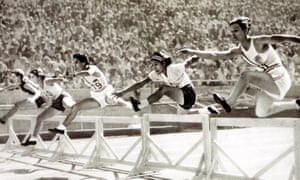There was a time when an England cricket team winning the Women’s World Cup was an “And finally …” item, the sort of thing the news presenter announced with an ironic smile. Not so last week, when Heather Knight’s cricketers pulled off a dramatic turnaround against India. Expect even more excitement if the football team pull off a similar coup in Euro 2017. These days, women’s sport makes headlines.
What it hasn’t had a chance to do yet, however, is make great literature. Look at any list of the greatest sports books of all time and you will struggle to find a female protagonist represented. Female athletes have been written about in some perfectly commendable biographies, but there is no classic of sporting reportage that captures the essence of female competition in the manner of Norman Mailer’s The Fight. Nor has a fictional writer ever elevated women’s sport to the intellectual heights of, for instance, the baseball novels of Don DeLillo (Underworld), Bernard Malamud (The Natural) or Philip Roth (The Great American Novel).
No, sporting women have not yet received their true due between the book covers. That’s not to say they’re absent, or unwelcome when they do appear. Lionel Shriver’s Double Fault – a novel virtually unknown until its successor, the Orange prize-winning We Need to Talk about Kevin, made Shriver’s name – contains a brilliant characterisation of a young tennis star who has given everything up for her sporting career. The film Million Dollar Baby couldn’t have scooped seven Oscars if it hadn’t first appeared among FX Toole’s excellent collection of boxing stories.
Even PG Wodehouse, who captured cricket and golf with fun and flair, understood that women could be as sport-obsessed as men. In his short story “Jane Gets off the Fairway”, a wayward wife is shocked back into marital fidelity when she realises that her young son, whose grip she has been neglecting, is holding his club incorrectly: “Now there he was, grasping the club as if it had been a spade … She shuddered to the very depths of her soul.”
Wodehouse also invented Honoria Glossop, whose heartiness intimidates her sometime fiance Bertie Wooster; you can trace a path from Honoria to the jolly-hockey-sticks antics of Enid Blyton’s schoolgirl characters. The tomboy trend was gaining ground in the 1930s and 40s, and heroines such as Darrell Rivers, the lacrosse-playing head girl of Malory Towers, were defying convention on the playing fields. Few were as barrier-breaking as the protagonist of Enid Bagnold’s 1935 book National Velvet. More than 80 years ago, Velvet achieved in fiction something still unmatched in real life when she rode the Piebald to victory and became the first female jockey to win the Grand National. She also managed it in her teens.

Arguably the greatest all-round athlete, Babe Didrikson Zaharias – whose talents included, but were not limited to, baseball, golf, boxing, fencing and track and field – has been the subject of a variety of books, of which the standout is Wonder Girl, the 2011 biography by Don Van Natta Jr. No less compelling is the story of Althea Gibson, the first tennis player to break the colour barrier, as told by Bruce Schoenfeld in The Match. A half-century before the Williams sisters fought their way from the streets of Compton to fame and fortune, Gibson was blazing a path from Harlem to Wimbledon, and Schoenfeld uses her friendship with another outsider – her Jewish doubles partner Angela Buxton – to weave a story of perseverance and triumph against sexism and racism.
A tale like Gibson’s is a reminder of how much we have missed out on by favouring male narratives for so long. It took until 1995 for Joan Ryan’s Little Girls in Pretty Boxes, an exposé of the brutal training regimes in gymnastics and figure skating, prevalent in the 80s and early 90s, to be published. And one of last year’s most moving and inspiring books about sport was Find a Way, the memoir of Diana Nyad, who at 64 became the first person to swim the shark-infested waters from Cuba to Florida – after failing at three previous attempts.
The London Olympics was a watershed in women’s sport; for the past five years, it has been taken more seriously than ever before by the public, the media and, in some cases, its own governing bodies. In the 80s, the most high-profile literary sporting heroines were the sex-addled showjumpers and pushy polo players you found in Jilly Cooper’s jodhpur sagas.
Last year a number of history books highlighted the importance of women in sport: they should surely herald a new age of literature about sport itself.
• Emma John’s Following On: A Memoir of Teenage Obsession and Terrible Cricket is out in paperback from Wisden. To order a copy for £8.49 (RRP £9.99) go to bookshop.theguardian.com or call 0330 333 6846. Free UK p&p over £10, online orders only. Phone orders min p&p of £1.99.



